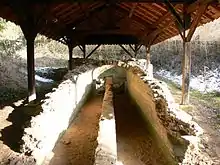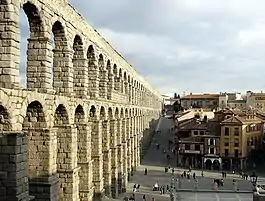Roman aqueduct
The Romans constructed aqueducts throughout their Republic and later Empire, to bring water from outside sources into cities and towns. Aqueduct water supplied public baths, latrines, fountains, and private households; it also supported mining operations, milling, farms, and gardens.
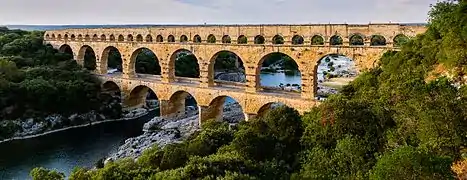
Aqueducts moved water through gravity alone, along a slight overall downward gradient within conduits of stone, brick, or concrete; the steeper the gradient, the faster the flow. Most conduits were buried beneath the ground and followed the contours of the terrain; obstructing peaks were circumvented or, less often, tunneled through. Where valleys or lowlands intervened, the conduit was carried on bridgework, or its contents fed into high-pressure lead, ceramic, or stone pipes and siphoned across. Most aqueduct systems included sedimentation tanks, which helped to reduce any water-borne debris. Sluices, castella aquae (distribution tanks) and stopcocks regulated the supply to individual destinations. In cities and towns, the run-off water from aqueducts scoured the drains and sewers.
Rome's first aqueduct was built in 312 BC, and supplied a water fountain at the city's cattle market. By the 3rd century AD, the city had eleven aqueducts, sustaining a population of over a million in a water-extravagant economy; most of the water supplied the city's many public baths. Cities and towns throughout the Roman Empire emulated this model, and funded aqueducts as objects of public interest and civic pride, "an expensive yet necessary luxury to which all could, and did, aspire".[1]
Most Roman aqueducts proved reliable and durable; some were maintained into the early modern era, and a few are still partly in use. Methods of aqueduct surveying and construction are noted by Vitruvius in his work De architectura (1st century BC). The general Frontinus gives more detail in his official report on the problems, uses and abuses of Imperial Rome's public water supply. Notable examples of aqueduct architecture include the supporting piers of the Aqueduct of Segovia, and the aqueduct-fed cisterns of Constantinople.
Background
Dionysius of Halicarnassus, Roman Antiquities[2]
Before the development of aqueduct technology, Romans, like most of their contemporaries in the ancient world, relied on local water sources such as springs and streams, supplemented by groundwater from privately or publicly owned wells, and by seasonal rain-water drained from rooftops into storage jars and cisterns.[3] The reliance of ancient communities upon such water resources restricted their potential growth. Rome's aqueducts were not strictly Roman inventions – their engineers would have been familiar with the water-management technologies of Rome's Etruscan and Greek allies – but they proved conspicuously successful. By the early Imperial era, the city's aqueducts supported a population of over a million, and an extravagant water supply for public amenities had become a fundamental part of Roman life.[4] The run-off of aqueduct water scoured the sewers of cities and towns. Water from aqueducts was also used to supply villas, ornamental urban and suburban gardens, market gardens, farms, and agricultural estates, the latter being the core of Rome's economy and wealth.[5]
Rome's aqueducts
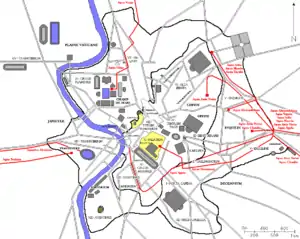

Rome had several springs within its perimeter walls but its groundwater was notoriously unpalatable; water from the river Tiber was badly affected by pollution and waterborne diseases. The city's demand for water had probably long exceeded its local supplies by 312 BC, when the city's first aqueduct, the Aqua Appia, was commissioned by the censor Appius Claudius Caecus. The Aqua Appia was one of two major public projects of the time; the other was a military road between Rome and Capua, the first leg of the so-called Appian Way. Both projects had significant strategic value, as the Third Samnite War had been under way for some thirty years by that point. The road allowed rapid troop movements; and by design or fortunate coincidence, most of the Aqua Appia ran within a buried conduit, relatively secure from attack. It was fed by a spring 16.4 km from Rome, and dropped 10 metres over its length to discharge approximately 75,500 cubic metres of water each day into a fountain at Rome's cattle market, the Forum Boarium, one of the city's lowest-lying public spaces.[6]
A second aqueduct, the Aqua Anio Vetus, was commissioned some forty years later, funded by treasures seized from Pyrrhus of Epirus. Its flow was more than twice that of the Aqua Appia, and it entered the city on raised arches, supplying water to higher elevations of the city.[7]
By 145 BC, the city had again outgrown its combined supplies. An official commission found the aqueduct conduits decayed, their water depleted by leakage and illegal tapping. The praetor Quintus Marcius Rex restored them, and introduced a third, "more wholesome" supply, the Aqua Marcia, Rome's longest aqueduct and high enough to supply the Capitoline Hill. The works cost 180,000,000 sesterces, and took two years to complete.[8] As demand grew still further, more aqueducts were built, including the Aqua Tepula in 127 BC and the Aqua Julia in 33 BC.
Aqueduct-building programmes in the city reached a peak in the Imperial Era; credit for the provision of public water supplies passed from mutually competitive Republican political magnates to the emperors. Augustus' reign saw the building of the Aqua Virgo, and the short Aqua Alsietina. The latter supplied Trastevere with large quantities of non-potable water for its gardens and was used to create an artificial lake for staged sea-fights to entertain the populace. Another short Augustan aqueduct supplemented the Aqua Marcia with water of "excellent quality".[9] The emperor Caligula added or began two aqueducts completed by his successor Claudius; the 69 km (42.8 mile) Aqua Claudia, which gave good quality water but failed on several occasions; and the Anio Novus, highest of all Rome's aqueducts and one of the most reliable but prone to muddy, discoloured waters, particularly after rain, despite its use of settling tanks.[10]
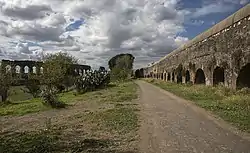
Most of Rome's aqueducts drew on various springs in the valley and highlands of the Anio, the modern river Aniene, east of the Tiber. A complex system of aqueduct junctions, tributary feeds and distribution tanks supplied every part of the city.[11] Trastevere, the city region west of the Tiber, was primarily served by extensions of several of the city's eastern aqueducts, carried across the river by lead pipes buried in the roadbed of the river bridges, thus forming an inverted siphon.[12] Whenever this cross-river supply had to be shut down for routine repair and maintenance works, the "positively unwholesome" waters of the Aqua Alsietina were used to supply Trastevere's public fountains.[9] The situation was finally ameliorated when the emperor Trajan built the Aqua Traiana in 109 AD, bringing clean water directly to Trastavere from aquifers around Lake Bracciano.[13]
By the late 3rd century AD, the city was supplied with water by 11 state-funded aqueducts. Their combined conduit length is estimated between 780 and a little over 800 kilometres, of which approximately 47 km (29 mi) were carried above ground level, on masonry supports. Most of Rome's water was carried by four of these: the Aqua Anio Vetus, the Aqua Marcia, the Aqua Claudia and the Aqua Anio Novus. Modern estimates of the city's supply, based on Frontinus' own calculations in the late 1st century, range from a high of 1,000,000 cubic meters per day to a more conservative 520,000–635,000 cubic meters per day, supplying an estimated population of 1,000,000.[14] Keenan-Jones et al., find Frontinus' figures and methodology too inaccurate and unreliable as a basis for calculation of actual water flow.[15]
Timeline
- 312 BC Aqua Appia
- 272 BC Aqua Anio Vetus
- 144-140 BC Aqua Marcia
- 127-126 BC Aqua Tepula
- 33 BC Aqua Julia
- 19 BC Aqua Virgo
- 2 BC Aqua Alsietana
- 38-52 AD Aqua Claudia
- 38-52 AD Aqua Appia Novus
- 109 AD Aqua Traiana
- 226 AD Aqua Alexandrina

Aqueducts in the Roman Empire
Hundreds of similar aqueducts were built throughout the Roman Empire. Many of them have since collapsed or been destroyed, but a number of intact portions remain. The Zaghouan Aqueduct, 92.5 km (57.5 mi) in length, was built in the 2nd century AD to supply Carthage (in modern Tunisia). Surviving provincial aqueduct bridges include the Pont du Gard in France and the Aqueduct of Segovia in Spain. The longest single conduit, at over 240 km, is associated with the Valens Aqueduct of Constantinople.[16] "The known system is at least two and half times the length of the longest recorded Roman aqueducts at Carthage and Cologne, but perhaps more significantly it represents one of the most outstanding surveying achievements of any pre-industrial society".[17] Rivalling this in terms of length and possibly equaling or exceeding it in cost and complexity, is the provincial Aqua Augusta that supplied a great number of luxury holiday-villas belonging to Rome's rich and powerful, several commercial fresh-water fisheries, market-gardens, vinyards and at least eight cities, including the major ports at Naples and Misenum; sea voyages by traders and the Roman Imperial navy required copious on-board supplies of fresh water.[18]
Planning, surveying and construction
Planning
Whether state-funded or privately built, aqueducts were protected and regulated by law. Any proposed aqueduct had to be submitted to the scrutiny of civil authorities. Permission (from the senate or local authorities) was granted only if the proposal respected the water rights of other citizens; on the whole, Roman communities took care to allocate shared water resources according to need.[19] The land on which a state-funded aqueduct was built might be state land (ager publicus) or privately owned, but in either case was subject to restrictions on usage and encroachment that might damage the fabric of the aqueduct, and rights of access for official inspection and maintenance. To this end, state funded aqueducts reserved a wide corridor of land, up to 15 feet each side of the aqueduct's outer fabric. Ploughing, planting and building were prohibited within this boundary. Such regulation was necessary to the aqueduct's long-term integrity and maintenance but was not always readily accepted or easily enforced at a local level, particularly when ager publicus was understood to be common property, to be used for whatever purpose seemed fit. Some privately built or smaller municipal aqueducts may have required less stringent and formal arrangements.[20]
Sources and surveying
Springs were by far the most common sources for aqueduct water; for example, most of Rome's supply came from various springs in the Anio valley and its uplands. Spring-water was fed into a stone or concrete springhouse, then entered the aqueduct conduit. Scattered springs would require several branch conduits feeding into a main channel. Some systems drew water from open, purpose-built, dammed reservoirs, such as the two (still in use) that supplied the aqueduct at the provincial city of Emerita Augusta.[21]
The territory over which the aqueduct ran had to be carefully surveyed to ensure the water would flow at a consistent and acceptable rate for the entire distance.[22] Roman engineers used various surveying tools to plot the course of aqueducts across the landscape. They checked horizontal levels with a chorobates, a flatbedded wooden frame fitted with a water level. Courses and angles could be plotted using a groma, a relatively simple apparatus that was eventually displaced by the more sophisticated dioptra, a precursor of the modern theodolite. In Book 8 of his De architectura, Vitruvius describes the need to ensure a constant supply, methods of prospecting, and tests for potable water.
Health issues
Greek and Roman physicians knew the association between stagnant or tainted waters and water-borne disease. In his De Medicina, the encyclopaedist Celsus warned that public bathing could induce gangrene in unhealed wounds.[23] Frontinus preferred a high rate of overflow in the system because it led to greater cleanliness in the water supply, the sewers, and those who used them. The adverse health effects of lead on those who mined and processed it were also well known, and for this reason, ceramic pipes were preferred over lead. Where lead pipes were used, a continuous water-flow and the inevitable deposition of water-borne minerals within the pipes somewhat reduced the water's contamination by soluble lead.[24] Lead content in Rome's aqueduct water was "clearly measurable, but unlikely to have been truly harmful". Nevertheless, the level of lead was 100 times higher than in local spring waters.[25]
Conduits and gradients
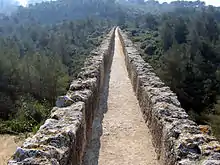
Most Roman aqueducts were flat-bottomed, arch-section conduits that ran 0.5 to 1 m beneath the ground surface, with inspection-and-access covers at regular intervals.[26] Conduits above ground level were usually slab-topped. Early conduits were ashlar-built but from around the late Republican era, brick-faced concrete was often used instead. The concrete used for conduit linings was usually waterproof, with a very smooth finish. The flow of water depended on gravity alone. The volume of water transported within the conduit depended on the catchment hydrology – rainfall, absorption, and runoff – the cross section of the conduit, and its gradient; most conduits ran about two-thirds full. The conduit's cross section was also determined by maintenance requirements; workmen must be able to enter and access the whole, with minimal disruption to its fabric.[27]
Vitruvius recommends a low gradient of not less than 1 in 4800 for the channel, presumably to prevent damage to the structure through erosion and water pressure. This value agrees well with the measured gradients of surviving masonry aqueducts. The gradient of the Pont du Gard is only 34 cm per km, descending only 17 m vertically in its entire length of 50 km (31 mi): it could transport up to 20,000 cubic metres a day. The gradients of temporary aqueducts used for hydraulic mining could be considerably greater, as at Dolaucothi in Wales (with a maximum gradient of about 1:700) and Las Medulas in northern Spain. Where sharp gradients were unavoidable in permanent conduits, the channel could be stepped downwards, widened or discharged into a receiving tank to disperse the flow of water and reduce its abrasive force.[28] The use of stepped cascades and drops also helped re-oxygenate and thus "freshen" the water.[29]
Bridgework and siphons
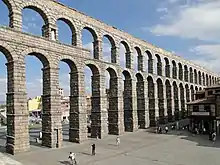
Some aqueduct conduits were supported across valleys or hollows on arches of masonry, brick or concrete; the Pont du Gard, one of the most impressive surviving examples of a massive masonry multiple-piered conduit, spanned the Gardon river-valley some 48.8 m (160 ft) above the Gardon itself. Where particularly deep or lengthy depressions had to be crossed, inverted siphons could be used, instead of arched supports; the conduit fed water into a header tank, which fed it into pipes. The pipes crossed the valley at lower level, supported by a low "venter" bridge, then rose to a receiving tank at a slightly lower elevation. This discharged into another conduit; the overall gradient was maintained. Siphon pipes were usually made of soldered lead, sometimes reinforced by concrete encasements or stone sleeves.
Less often, the pipes themselves were stone or ceramic, jointed as male-female and sealed with lead.[30] Vitruvius describes the construction of siphons and the problems of blockage, blow-outs and venting at their lowest levels, where the pressures were greatest. Nonetheless, siphons were versatile and effective if well-built and well-maintained. A horizontal section of high-pressure siphon tubing in the Aqueduct of the Gier was ramped up on bridgework to clear a navigable river, using nine lead pipes in parallel, cased in concrete.[31][32] Modern hydraulic engineers use similar techniques to enable sewers and water pipes to cross depressions. At Arles, a minor branch of the main aqueduct supplied a local suburb via a lead siphon whose "belly" was laid across a riverbed, eliminating any need for supporting bridgework.[33]
Inspection and maintenance
Roman aqueducts required a comprehensive system of regular maintenance. The "clear corridors" created to protect the fabric of underground and overground conduits were regularly patrolled for unlawful ploughing, planting, roadways and buildings. In De aquaeductu, Frontinus describes the penetration of conduits by tree-roots as particularly damaging.[20] The aqueducts conduits would have been regularly inspected and maintained by working patrols, to reduce algal fouling, repair accidental breaches or shoddy workmanship, to clear the conduits of gravel and other loose debris, and to remove accretions of calcium carbonate (also known as travertine) in systems fed by hard water sources; even slight roughening of the aqueduct's ideally smooth-mortared interior surface by travertine deposits could significantly reduce the water's velocity, and thus its rate of flow, by up to 1/4. [34] Inspection and access points were provided at regular intervals on the standard, buried conduits. Accretions within syphons could drastically reduce flow rates through their already narrow diameters, though some had sealed openings that might have been used as rodding eyes, possibly using a pull-through device. In Rome, where a hard-water supply was the norm, mains pipework was shallowly buried beneath road kerbs, for ease of access; the accumulation of calcium carbonate in these pipes would have necessitated their frequent replacement.[35]
The aqueducts were under the overall care and governance of a water commissioner (curator aquarum); this was a high status, high-profile appointment. In 97, Frontinus served both as consul and as curator aquarum, under the emperor Nerva.[36] Little is known of the day-to-day business of aqueduct maintenance teams (aquarii). Under the emperor Claudius, Rome's contingent of imperial aquarii comprised a familia aquarum of 700 people both slave and free, funded through a combination of Imperial largesse and the water taxes and fees paid by private individuals. The familia aquarum was supervised by an Imperial freedman, who held office as procurator aquarium.[37] Theirs was probably a never-ending routine of patrol, inspection and cleaning, punctuated by occasional emergencies. Full closure of any aqueduct for servicing would have been a rare event, kept as brief as possible, with repairs preferably made when water demand was lowest, during the winter months.[38] The water supply could be shut off at its aqueduct outlet when small or local repairs were needed, but substantial maintenance and repairs to the aqueduct conduit itself required the complete diversion of water at any point upstream, including the spring-head itself. Frontinus also describes the use of temporary leaden conduits to carry the water past damaged stretches while repairs were made, with minimal loss of supply.
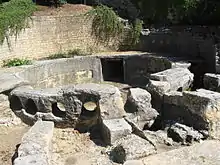
Distribution
Aqueduct mains could be directly tapped, but they more usually fed into public distribution terminals, known as castellum aquae ("water castles"), which acted as settling tanks and cisterns and supplied various branches and spurs, via lead or ceramic pipes. These pipes were made in 25 different standardised diameters and were fitted with bronze stopcocks. The flow from each pipe (calix) could therefore be fully or part-opened, or shut down, and its supply diverted to any other part of the system in which water-demand was, for the time being, outstripping supply. The free supply of water to public basins and drinking fountains was officially prioritised over the supply to the public baths; a small fee was charged to every bather, on behalf of the Roman people. The supply to basins and baths was in turn prioritised over the requirements of fee-paying private users.[39]The last were registered, along with the bore of pipe that led from the public water supply to their property – the wider the pipe, the greater the flow and the higher the fee.
Frontinus thought dishonest private uses were responsible for most of the losses and outright thefts of water in Rome. Tampering and fraud to avoid or reduce payment were commonplace; methods included the fitting of unlicensed or additional outlets, some of them many miles outside the city, and the illegal widening of lead pipes. In law, water grants were issued by the emperor to named individuals, and could not be sold along with a property, or inherited: new owners and heirs must therefore negotiate a new grant, in their own name. But in practise, grants were more often transferred than not. Any of this might involve the bribery or connivance of unscrupulous aqueduct officials or workers. Archaeological evidence confirms that some users drew an illegal supply but not the likely quantity involved, nor the effect on supply to the city as a whole. To compound the problems, the measurement of allowances, and Frontinus' own calculations, were basically flawed and confused. While officially approved lead pipes carried inscriptions with information on the pipe's manufacturer, its fitter, and probably on its subscriber and their entitlement, water allowance was measured in quinaria (cross-sectional area of the pipe) at the point of supply. No formula or physical device was employed to account for variations in velocity, rate of flow or actual usage.[40][41][42]
Uses
Civic and domestic
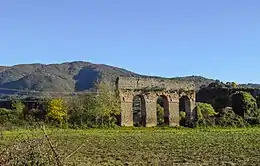
Rome's first aqueduct (312 BC) discharged at very low pressure and at a more-or-less constant rate in the city's main trading centre and cattle-market, probably into a low-level, cascaded series of troughs or basins; the upper for household use, the lower for watering the livestock traded there. Most Romans would have filled buckets and storage jars at the basins and carried the water to their apartments; the better-off would have sent slaves to perform the same task. The outlet's elevation was too low to offer any city household or building a direct supply; the overflow drained into Rome's main sewer, and from there into the Tiber. Most inhabitants still relied on well-water and rainwater. At this time, Rome had no public baths. The first were probably built in the next century, based on precursors in neighboring Campania; a limited number of private baths and small, street-corner public baths would have had a private water supply, but once aqueduct water was brought to the city's higher elevations, large and well-appointed public baths were built throughout the city, and drinking water was delivered to public fountains at high pressure. Public baths and fountains became distinctive features of Roman civilization, and the baths in particular became important social centres.[43][44]
The majority of urban Romans lived in multi-storeyed blocks of flats (insulae). Some blocks offered water services, but only to tenants on the more expensive, lower floors; the rest would have drawn their water gratis from public fountains. During the Imperial era, lead production (mostly for pipes) became an Imperial monopoly, and the granting of rights to draw water for private use from state-funded aqueducts was made an imperial privilege.[45] The provision of free, potable water to the general pubic became one among many gifts to the people of Rome from their emperor, paid for by him or by the state. In Frontino's time, around 10% of Rome's aqueduct water was used to supply 591 public fountains.[46]
Farming
Between 65 and 90% of the Roman Empire's population was involved in some form of agricultural work. Water was possibly the most important variable in the agricultural economy of the Mediterranean world. Roman Italy's natural water sources – springs, streams, rivers and lakes – were unevenly distributed across the landscape, and water tended to scarcity when most needed, during the warm, dry summer growing season. Farmers whose villas or estates were near a public aqueduct could draw, under license, a specified quantity of aqueduct water for summer irrigation at a predetermined time; this was intended to limit the depletion of water supply to users further down the gradient, and help ensure a fair distribution among competitors at the time when water was most needed and scarce. Columella recommends that any farm should contain a spring, stream or river;[47] but acknowledges that not every farm did.
Farmland without a reliable summer water-source was virtually worthless. During the growing season, the water demand of a "modest local" irrigation system might consume as much water as the city of Rome; and the livestock whose manure fertilised the fields must be fed and watered all year round. At least some Roman landowners and farmers relied in part or whole on aqueduct water to raise crops as their primary or sole source of income but the fraction of aqueduct water involved can only be guessed at. More certainly, the creation of municipal and city aqueducts brought a growth in the intensive and efficient suburban market-farming of fragile, perishable commodities such as flowers (for perfumes, and for festival garlands), grapes, vegetables and orchard fruits; and of small livestock such as pigs and chickens, close to the municipal and urban markets.[48]
A licensed right to use aqueduct water on farmland could lead to increased productivity, a cash income through the sale of surplus foodstuffs, and an increase in the value of the land itself. In the countryside, permissions to draw aqueduct water for irrigation were particularly hard to get; the exercise and abuse of such rights were subject to various known legal disputes and judgements, and at least one political campaign; in the early 2nd century BC Cato tried to block all unlawful rural outlets, especially those owned by the landed elite - "Look how much he bought the land for, where he is channeling the water!" - during his censorship. His attempted reform proved impermanent at best. Though illegal tapping could be punished by seizure of assets, including the illegally watered land and its produce, this law seems never to have been used, and was probably impracticable; food surpluses kept prices low. Grain shortages in particular could lead to famine and social unrest. Any practical solution must strike a balance between the water-needs of urban populations and grain producers, tax the latter's profits, and secure sufficient grain at reasonable cost for the Roman poor (the so-called "corn dole") and the army. Rather than seek to impose unproductive and probably unenforcable bans, the authorities issued individual water grants (though seldom in rural areas) and licenses, and regulated water outlets, with variable success. In the 1st century AD, Pliny the Elder, like Cato, could fulminate against grain producers who continued to wax fat on profits from public water and public land.[49]
Some landholders avoided such restrictions and entanglements by buying water access rights to distant springs, not necessarily on their own land. A few, of high wealth and status, built their own aqueducts to transport such water from source to field or villa; Mumius Niger Valerius Vegetus bought the rights to a spring and its water from his neighbour, and access rights to a corridor of intervening land, then built an aqueduct of just under 10 kilometres, connecting the springhead to his own villa. The senatorial permission for this "Aqua Vegetiana" was given only when the project seemed not to impinge on the water rights of other citizens.[50]
Industrial
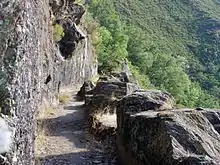
Some aqueducts supplied water to industrial sites, usually via an open channel cut into the ground, clay lined or wood-shuttered to reduce water loss. Most such leats were designed to operate at the steep gradients that could deliver the high water volumes needed in mining operations. Water was used in hydraulic mining to strip the overburden and expose the ore by hushing, to fracture and wash away metal-bearing rock already heated and weakened by fire-setting, and to power water-wheel driven stamps and trip-hammers that crushed ore for processing. Evidence of such leats and machines has been found at Dolaucothi in south-west Wales.[51][52]
Mining sites such as Dolaucothi and Las Medulas in northwest Spain show multiple aqueducts that fed water from local rivers to the mine head. The channels may have deteriorated rapidly, or become redundant as the nearby ore was exhausted. Las Medulas shows at least seven such leats, and Dolaucothi at least five. At Dolaucothi, the miners used holding reservoirs as well as hushing tanks, and sluice gates to control flow, as well as drop chutes for diversion of water supplies. The remaining traces (see palimpsest) of such channels allows the mining sequence to be inferred.
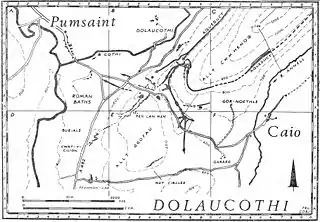
A number of other sites fed by several aqueducts have not yet been thoroughly explored or excavated, such as those at Longovicium near Lanchester south of Hadrian's wall, in which the water supplies may have been used to power trip-hammers for forging iron.
At Barbegal in Roman Gaul, a reservoir fed an aqueduct that drove a cascaded series of 15 or 16 overshot water mills, grinding flour for the Arles region. Similar arrangements, though on a lesser scale, have been found in Caesarea, Venafrum and Roman-era Athens. Rome's Aqua Traiana drove a flour-mill at the Janiculum, west of the Tiber. A mill in the basement of the Baths of Caracalla was driven by aqueduct overspill; this was but one of many city mills driven by aqueduct water, with or without official permission. A law of the 5th century forbade the illicit use of aqueduct water for milling.[53]
Decline in use
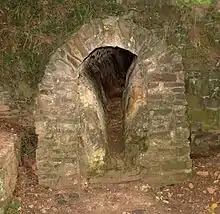
During the fall of the Roman Empire, some aqueducts were deliberately cut by enemies but more fell into disuse because of deteriorating Roman infrastructure and lack of maintenance, such as the Eifel aqueduct (pictured right). Observations made by the Spaniard Pedro Tafur, who visited Rome in 1436, reveal misunderstandings of the very nature of the Roman aqueducts:
Through the middle of the city runs a river, which the Romans brought there with great labour and set in their midst, and this is the Tiber. They made a new bed for the river, so it is said, of lead, and channels at one and the other end of the city for its entrances and exits, both for watering horses and for other services convenient to the people, and anyone entering it at any other spot would be drowned.[54]
During the Renaissance, the standing remains of the city's massive masonry aqueducts inspired architects, engineers and their patrons; Pope Nicholas V renovated the main channels of the Roman Aqua Virgo in 1453.[55] Many aqueducts in Rome's former empire were kept in good repair. The 15th-century rebuilding of an aqueduct at Segovia in Spain shows advances on the Pont du Gard by using fewer arches of greater height, and so greater economy in its use of the raw materials. The skill in building aqueducts was not lost, especially of the smaller, more modest channels used to supply water wheels. Most such mills in Britain were developed in the medieval period for bread production, and used similar methods as that developed by the Romans with leats tapping local rivers and streams.
See also
References
- Gargarin, M. and Fantham, E. (editors). The Oxford Encyclopedia of Ancient Greece and Rome, Volume 1. p. 145.
- Cited by Quilici, Lorenzo (2008). "Land Transport, Part 1: Roads and Bridges" in Oleson, John Peter (ed.): The Oxford Handbook of Engineering and Technology in the Classical World. Oxford University Press. New York. ISBN 978-0-19-518731-1. pp. 551–579 (552).
- Mays, L. (editor). Ancient Water Technologies. Springer. 2010. pp. 115–116.
- Gargarin, M. and Fantham, E. (editors). The Oxford Encyclopedia of Ancient Greece and Rome, Volume 1. Oxford University Press. 2010. pp. 144–145.
- Cynthia Bannon, Gardens and Neighbors: Private Water Rights in Roman Italy. University of Michigan Press, 2009, pp. 65–73.
- The Roman general and hydraulic engineer Frontinus later calculated its delivery at 1825 quinariae (75,537 cubic meters) in 24 hours; see Samuel Ball Platner (1929, as completed and revised by Thomas Ashby): A Topographical Dictionary of Ancient Rome. London: Oxford University. p. 29.
- Sextus Julius Frontinus. The Aqueducts of Rome. pp.1, 6–20.
- Sextus Julius Frontinus, The Aqueducts of Rome, 6–20,
- The Aqua Alsietina was also known as "Aqua Augusta"; Frontinus distinguishes its "unwholesome" supply from the "sweet waters" of the Aqua Augusta that fed into the Aqua Marcia. On the one hand, he says the Naumachia's supply is "nowhere delivered for consumption by the people... [but the surplus is allowed] to the adjacent gardens and to private users for irrigation". On the other hand, "It is customary, however, in the district across the Tiber, in an emergency, whenever the bridges are undergoing repairs and the water supply is cut off from this side of the river, to draw from Alsietina to maintain the flow of the public fountains." Frontinus, The Aqueducts of Rome 1, 6–20.
- Sextus Julius Frontinus, The Aqueducts of Rome, 6–20
- CARON, André. "THE AQUEDUCTS". www.maquettes-historiques.net. Retrieved 17 September 2017.
- Taylor, Rabun (2002), Tiber River bridges and the development of the ancient city of Rome, pp. 16–17, accessed 22 June 2013
- Hodge, A. Trevor, Roman Aqueducts and Water Supply, Duckworth Archaeology, 2002, pp. 255 – 6, and note 43.
- Brun, (1991) p.99; Brun, (2013), pp. 306 - 307; population estimate, Carcopino, (1940), p. 18, cited in Brun, (1991).
- Keenan-Jones, (2015)
- Mango (1995) p.17
- Jelena Bogdanovic, Historical and Archaeological Context Constantinople and the longest Roman aqueduct Accessed August 28, 2016.
- Da Feo, G., and Napoli, R. M. A., "Historical development of the Augustan Aqueduct in Southern Italy: twenty centuries of works from Serino to Naples", Water Science & Technology Water Supply, March 2007, pp. 131 - 133
- Cynthia Bannon, Gardens and Neighbors: Private Water Rights in Roman Italy. University of Michigan Press, 2009, pp. 5-10
- Taylor, R., Public Needs and Private Pleasures: Water Distribution, the Tiber River and the Urban Development of Ancient Rome, (Studia Archaeologica), L'ERMA di BRETSCHNEIDER, 2000, pp. 56-60
- Mays, L., (Editor), Ancient Water Technologies, Springer, 2010. p. 116.
- Taylor, R. (2012). Rome's Lost Aqueduct. (Cover story). Archaeology, 65(2), 34–40.
- Celsus De Medicina, 2, 28.(Loeb)
- James Grout, Encyclopedia Romana, Lead Poisoning and Rome (accessed 21 May 2013)
- Delile, Hugo; Blichert-Toft, Janne; Goiran, Jean-Philippe; Keay, Simon; Albarède, Francis (6 May 2014). "Lead in ancient Rome's city waters". Proceedings of the National Academy of Sciences. 111 (18): 6594–6599. Bibcode:2014PNAS..111.6594D. doi:10.1073/pnas.1400097111. PMC 4020092. PMID 24753588.
- Hodge, A. Trevor, Roman Aqueducts and Water Supply, Duckworth Archaeology, 2002. pp. 93–4.
- Hodge, A. Trevor, Roman Aqueducts and Water Supply, Duckworth Archaeology, 2002. p. 2.
- Mays, L., (Editor), Ancient Water Technologies, Springer, 2010. p. 119.
- H. Chanson, "Hydraulics of Roman Aqueducts: Steep Chutes, Cascades, and Drop Shafts," American Journal of Archaeology, Vol. 104 No. 1 (2000). 47-51.
- Hodge, A. Trevor, Roman Aqueducts and Water Supply, Duckworth Archaeology, 2002. pp. 110 – 11.
- The sense of venter as "belly" is apparent in Vitruvius 8.6: "if there be long valleys, and when it [the water] arrives at the bottom, let it be carried level by means of a low substruction as great a distance as possible; this is the part called the venter, by the Greeks koilia; when it arrives at the opposite acclivity, the water therein being but slightly swelled on account of the length of the venter, it may be directed upwards... Over the venter long stand pipes should be placed, by means of which, the violence of the air may escape. Thus, those who have to conduct water through leaden pipes, may by these rules, excellently regulate its descent, its circuit, the venter, and the compression of the air."Vitruvius, 8.6.5-6, trans Gwilt
- Mays, L., (Editor), Ancient Water Technologies, Springer, 2010. p.120.
- Taylor, R., Public Needs and Private Pleasures: Water Distribution, the Tiber River and the Urban Development of Ancient Rome, (Studia Archaeologica), L'ERMA di BRETSCHNEIDER, 2000, p. 31
- Keenan-Jones, (2015) pp. 1-8
- Taylor, R., Public Needs and Private Pleasures: Water Distribution, the Tiber River and the Urban Development of Ancient Rome (Studia Archaeologica), L'ERMA di BRETSCHNEIDER, 2000, pp. 30-33, for calcined accretions and replacement of pipework. Water regulations prescribed a 5 foot distance between buildings and mains piping; an urban version of the protective "corridors" afforded to aqueducts.
- Hodge, A. Trevor, Roman Aqueducts and Water Supply, Duckworth Archaeology, 2002, pp. 16-17: Frontinus had already had a distinguished career as consul, general and provincial governor; and he served again as consul in 100
- Taylor, R., Public Needs and Private Pleasures: Water Distribution, the Tiber River and the Urban Development of Ancient Rome, (Studia Archaeologica), L'ERMA di BRETSCHNEIDER, 2000, pp. 30-33
- Hodge, A. Trevor, Roman Aqueducts and Water Supply, Duckworth Archaeology, 2002; debris and gravel, pp. 24−30, 275: calcium carbonate, pp. 2, 17, 98: apertures in pipes as possible rodding eyes, p. 38.
- Prioritised public supply and private fees in Vitruvius de Architectura, VIII, 6, 1 -2.
- Hodge, A. Trevor, Roman Aqueducts and Water Supply, Duckworth Archaeology, 2002, pp. 291−298, 305−311, and footnotes.
- Only a single, damaged and probably corrupted copy of Frontinus' work has survived. Frontinus may have overemphasised the likely role of theft to shift attention from his poor grasp of the problems involved in estimations of flow measurement and water loss. See Keenan-Jones, (2015), pp. 2-3
- H B Evans, Water Distribution in Ancient Rome: The Evidence of Frontinus, University of Michigan Press, 1997, pp. 41−43, 72.
- For the earliest likely development of Roman public bathing, see Fagan, Garrett T., Bathing in Public in the Roman World, University of Michigan Press, 1999, pp. 42−44. googlebooks preview
- Hodge, A. Trevor, Roman Aqueducts and Water Supply, Duckworth Archaeology, 2002, pp. 3, 5, 49.
- Taylor, R., Public Needs and Private Pleasures: Water Distribution, the Tiber River and the Urban Development of Ancient Rome, (Studia Archaeologica), L'ERMA di BRETSCHNEIDER, 2000, pp. 85-86
- Keenan-Jones, (2015) pp. 1-2
- Columella, De Re Rustica, Book 1, English translation at Loeb Classical Library, 1941
- Cynthia Bannon, Gardens and Neighbors: Private Water Rights in Roman Italy. University of Michigan Press, 2009, pp. 5−10; citing Hodge, Roman Aqueducts, pp. 246 – 247 for estimate on water consumption by irrigation.
- Cynthia Bannon, Gardens and Neighbors: Private Water Rights in Roman Italy. University of Michigan Press, 2009, pp. 5−10; citing Hodge, Roman Aqueducts, pp. 246−247 for estimate on water consumption by irrigation; p. 219 for Cato's legislation on misuse of water: the quotation is from Cato's speech against L. Furius Purpureus, who was consul in 196 BC.
- Cynthia Bannon, Gardens and Neighbors: Private Water Rights in Roman Italy. University of Michigan Press, 2009, p. 73.
- Wilson, Andrew (2002): "Machines, Power and the Ancient Economy", The Journal of Roman Studies, Vol. 92, pp. 1–32 (21f.), p. 21f.
- Lewis, M.J.T., "Millstone and Hammer: the Origins of Water Power", Hull Academic Press, 1998, Section 2.
- Hodge, A. Trevor, Roman Aqueducts and Water Supply, Duckworth Archaeology, 2002. pp. 255−258. [Paperback]
- Pedro Tafur, Travels and Adventures (1435–1439), trans. Malcolm Letts, Harper & brothers, 1926. link to washington.edu
- Gross, Hanns (1990). Rome in the Age of Enlightenment: the Post-Tridentine syndrome and the ancien regime. New York: Cambridge University Press. p. 28. ISBN 0-521-37211-9.
Bibliography
- Blackman, Deane R., Hodge, A. Trevor (2001). "Frontinus' Legacy". University of Michigan Press.
- Bossy, G.; G. Fabre, Y. Glard, C. Joseph (2000). "Sur le Fonctionnement d'un Ouvrage de Grande Hydraulique Antique, l'Aqueduc de Nîmes et le Pont du Gard (Languedoc, France)" in Comptes Rendus de l'Académie des Sciences de Paris. Sciences de la Terre et des Planètes. Vol. 330, pp. 769–775.
- Bruun, C., (1991). "The Water Supply of Ancient Rome, a Study of Roman Imperial Administration". Helsinki, Finland: Societas Scientiarum Fennica. [Google Scholar]
- Bruun, C., (2013). "Water supply, drainage and watermills", In: The Cambridge Companion to Ancient Rome, editor, Erdkamp, Paul, pp. 297–313. New York: Cambridge University Press.
- Carcopino, J. (1940). Daily Life in Ancient Rome, translated by E. O. Lorimer. New Haven, Connecticut: Yale University Press.
- Chanson, H. (2002). "Certains Aspects de la Conception hydraulique des Aqueducs Romains". Journal La Houille Blanche. No. 6/7, pp. 43–57.
- Chanson, H. (2008). "The Hydraulics of Roman Aqueducts: What do we know? Why should we learn ?" in Proceedings of World Environmental and Water Resources Congress 2008 Ahupua'a. ASCE-EWRI Education, Research and History Symposium, Hawaii, USA. Invited Keynote lecture, 13–16 May, R.W. Badcock Jr and R. Walton Eds., 16 pages (ISBN 978-0-7844-0976-3)
- Coarelli, Filippo (1989). Guida Archeologica di Roma. Milano: Arnoldo Mondadori Editore.
- Claridge, Amanda (1998). Rome: An Oxford Archaeological Guide. New York: Oxford University Press.
- Fabre, G.; J. L. Fiches, J. L. Paillet (2000). L'Aqueduc de Nîmes et le Pont du Gard. Archéologie, Géosystème, Histoire. CRA Monographies Hors Série. Paris: CNRS Editions.
- Gebara, C.; J. M. Michel, J. L. Guendon (2002). "L'Aqueduc Romain de Fréjus. Sa Description, son Histoire et son Environnement", Revue Achéologique de Narbonnaise, Supplément 33. Montpellier, France.
- Hodge, A.T. (2001). Roman Aqueducts & Water Supply, 2nd ed. London: Duckworth.
- Kamash, Zena (2010). Archaeologies of Water in the Roman Near East. Gorgias Press.
- Keenan-Jones, Duncan; Motta, Davide; Garcia, Marcelo H; Fouke, Bruce, W. "Travertine-based estimates of the amount of water supplied by ancient Rome's Anio Novus aqueduct", Journal of Archaeological Science: Reports, Science Direct, Volume 3, September 2015, pp. 1 - 10 (accessed online January 30 2021)
- Leveau, P. (1991). "Research on Roman Aqueducts in the Past Ten Years" in T. Hodge (ed.): Future Currents in Aqueduct Studies. Leeds, UK, pp. 149–162.
- Lewis, P. R.; G. D. B. Jones (1970). "Roman gold-mining in north-west Spain". Journal of Roman Studies 60 : 169-85.
- Lewis, P. R.; G. D. B. Jones (1969). "The Dolaucothi gold mines, I: the surface evidence". The Antiquaries Journal, 49, no. 2: 244–72.
- Martínez Jiménez, J. (2019). Aqueducts and Urbanism in post-Roman Hispania. Gorgias Press.
- Mango, C. (1995). "The Water Supply of Constantinople". In C. Mango, G. Dagron, et al. (eds) Constantinople and its Hinterland. pp. 9-18. Aldershot.
- Sánchez López, E. & Martínez Jiménez, J. (2016). Los Acueductos de Hispania: Construcción y Abandono, Madrid .(Text online).
- Taylor, R., Public Needs and Private Pleasures: Water Distribution, the Tiber River and the Urban Development of Ancient Rome, (Studia Archaeologica) L'ERMA di BRETSCHNEIDER, 2000.
- Tucci, Pier Luigi (2006). "Ideology and technology in Rome’s water supply: castella, the toponym AQVEDVCTIVM, and supply to the Palatine and Caelian hill". Journal of Roman Archaeology 19 : 94-120.
External links
| Wikimedia Commons has media related to Ancient Roman aqueducts. |
- Sextus Julius Frontinus. De Aquaeductu Urbis Romae (On the water management of the city of Rome). Translated by R. H. Rodgers. University of Vermont. 2003.
- Lacus Curtius – entry on Roman waterworks, uchicago.edu
- Aqueduct survey on-line project
- 600 Roman aqueducts – with 25 descriptions in detail, romanaqueducts.info
- Map of Roman aqueducts (in Italian), archeoroma.com
- Planimetry of Ancient aqueducts in Roman countryside (in Italian), acquedottidiroma.it
- Recent advances in study of Roman aqueducts by Chanson
- Hubert Chanson – A dozen freely available published research articles on Roman aqueduct hydraulics and culvert design, and related topics by Professor Hubert Chanson, Department of Civil Engineering, University of Queensland.
- John Hooper, Secrets of Roman aqueduct lie in chapel. The Guardian. 24 January 2010.
